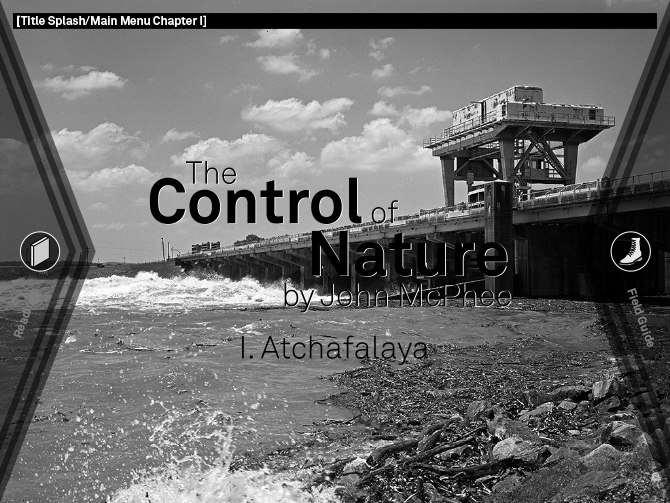9.2012 - 10.2012
In collaboration with Ian Besler and Nancy Kwon
Brief
The goal of the project was to design the future of non-fiction books using using the best practices of interactive design and the concepts from productive interaction. Textbooks, reference, how-to, history, and other rich informational books have much to gain from interaction and the range of media (text, color image, video, interactive graphics, audio, etc.) that digital delivery systems offer.
“The San Gabriels, in their state of tectonic youth, are rising as rapidly as any range on earth. Their loose, inimical slopes flout the tolerance of the angle of repose. Rising straight up out of the megalopolis, they stand ten thousand feet above the nearby sea, and they are not kidding with this city” (pg. #45, emphasis added).
McPhee’s work, The Control of Nature (1989) addresses the friction and conflict that arises at “the confrontation of the urban and the wild” (pg. #45). We feel that the affordances presented by the e-book format and the speculative device relationship are uniquely suited for a work exploring what it means to be an inhabitant of a natural space in an urban context.
So much of our definition of civil progress is embedded in the notion of pacifying and subjugating natural forces to our direction. After all, roads are, in aggregate, rocks combined with a binding agent; natural elements bent to our will. Water and sewerage systems are rivers and streams dictated by human settlement. We feel that a glut of technology works to sever the connection between our day-to-day activities and the natural context of the ecosystems around us. We propose to explore an e-book and secondary device that not only serves to connect the reader to the landscape around her/him, but to connect her/him to the systems and relationships of human settlement in the context of the natural world and motivate a general curiosity in the reader toward her/his natural environment, especially in apparently mundane and day-to-day contexts.
“Like the freeways, the debris-control system ordinarily functions, but occasionally jams” (pg. #55).
“This was to create the impression that the debris pours forth from the mountains continually, perennially, perpetually — which it does and does not, there being a great temporal disparity between the pace at which the mountains behave and the way people think” (pg. #59, emphasis added).
Concept




We wanted our design to have a strong bond to local community, through the content of the book. The book suggests various points of view to natural phenomenons, where we thought we can also suggests another layer of perspective through interactive experience -- how natural phenomenons are interacting with human society.
The E-book






The e-book largely consist of two parts -- readings and field guide. The reading part contains texts of the book, however, we noticed that the specific writing style of McFee -- driving an article through series of short stories -- has an interesting potential of interactivity. We broke down the text to short stories, and located them on a map, of Mt. San Gabriel in this case. Readers can access to each of the stories by touching the icons, and the text comes up with other media such as photographs, audios and videos.
The second part of the e-book is field guide, where the deeper attachment to readers' local comes in. The field guide has a similar interface to the reading part, the difference is that all the 'story entries' are submitted by other local users of the e-book. Users are allowed to pin any story that tells connection between natural phenomenons and the local community with various media materials. And that where our second device comes.
HERE/SAY


The e-book's second device, HERE/SAY, is a swiss-knife type viewfinder, that allows users to take photographs, record audio/video, submit stories. To upload a story to the e-book community, one should go out to field and need to be at the place relevant to the story. Story entires once submitted are virtually 'left' at the place, waiting for other users to come and 'pick up', who would be noticed by the e-book through social network connection.
Created with : Adobe Flash, Illustrator, Photoshop, Acrylic boards.